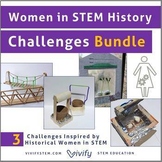Botany STEM Challenge - Plant Anatomy & Engineering Women's History Activity
- PDF
What educators are saying
Also included in
- Combine social studies and STEM with these challenges inspired by historical women in STEM fields. Students will use the engineering design process to solve challenges related to the work of pioneering female scientists and engineers. Each challenge includes:- Detailed teachers guides with links toPrice $13.80Original Price $17.25Save $3.45
- Are you in need of year-round STEM activities? This growing bundle includes ALL Vivify K-12 STEM lessons from team challenges, engineering design, semester-long STEM units, research projects, and more! Purchase everything for 20% off individual products! Here is a sample of what is included: Stage 1Price $990.24Original Price $1237.80Save $247.56
Description
Perfect for Earth Day! In this extensive Botany STEM Challenge, students create window greenhouses and observe plant growth. Then they use the engineering design process to build a plant transportation device to safely carry their saplings home! This challenge also highlights Katherine Esau, a pioneer in Botany. History, science, engineering, and math-- it is all included along with teacher instructions and student handouts.
This hands-on activity includes a design challenge that allows students to work in teams, apply the engineering design process, and connect math topics to real-world applications. As a student-driven assignment, the purpose of the teacher is to act as a facilitator. You will provide the structure to the project, but students will take an active role in designing and building a plant transportation device to hold a plant that is watered. Our students have loved this activity, and we know yours will too!
This packet includes:
- Detailed teachers guide with links to resources
- Printable window greenhouse with instructions
- Plant anatomy handouts
- Student handouts to guide them through the engineering design process
- Student recording sheets for each step of the process
- Math connection problems including graphing, ratios, measurements, perimeter, area, and volume (applicable sheets in both SI and metric units).
Looking for more STEM lessons? Our team of engineers and educators is dedicated to developing low-prep and high-quality STEM activities for any classroom! Click below to learn more:
- Vivify's Scope & Sequence + Standards Alignment
- Vivify's Resource Guide
- Learn about the 3 Stages of STEM
- Vivify STEM Membership
Customer Tips:
• Click the Green ★ to follow our store and get notifications of new products and freebies
• Leave feedback to receive TpT credit for use on future purchases
• Questions? Contact us in the Product Q&A section
♥ Connect With Us ♥
Email us: info@vivifystem.com







